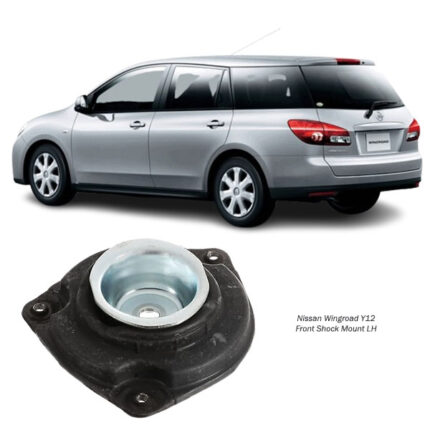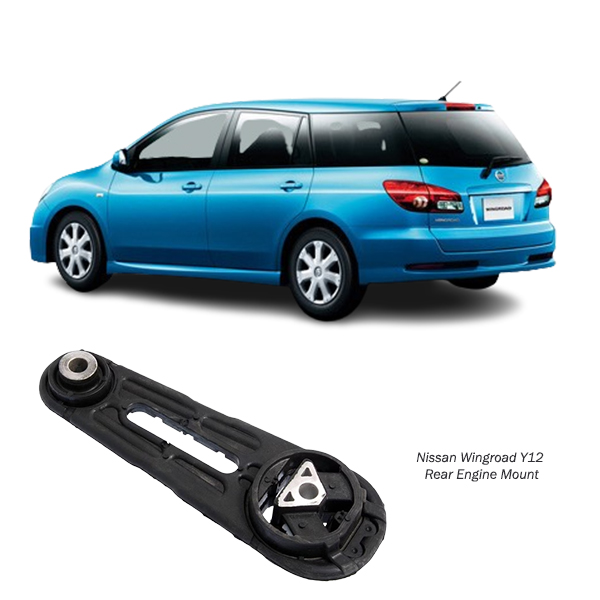-8%
Get Nissan Wingroad Y12 Rear Buffer Engine Mounting Assy 11360-ED000 in Kenya
The Rear Buffer Engine Mounting Assembly plays a critical role in modern vehicles, ensuring that the engine operates efficiently while minimizing vibrations, noise, and stress on the chassis. This guide explores its purpose, construction, benefits, maintenance, and troubleshooting, providing a comprehensive understanding of this essential component.
What is a Rear Buffer Engine Mounting Assembly?
The Rear Buffer Engine Mounting Assembly, often referred to as the rear engine mount, is a component of the engine mounting system. It is positioned at the rear of the engine and serves to:
- Secure the Engine
- Hold the engine firmly in place within the engine bay.
- Dampen Vibrations
- Absorb vibrations and shocks generated by the engine during operation.
- Protect the Chassis
- Reduce stress on the vehicle’s frame by isolating engine movement.
This assembly includes a combination of rubber, metal, and sometimes hydraulic or electronic elements to ensure optimal performance and durability.
Functions of the Rear Buffer Engine Mounting Assembly
- Engine Stabilization
- Prevents the engine from excessive movement during acceleration, deceleration, and cornering.
- Vibration and Noise Isolation
- Reduces the transmission of engine vibrations and noise to the vehicle’s cabin, enhancing ride comfort.
- Alignment Maintenance
- Maintains the correct alignment of the engine with the transmission and other drivetrain components.
- Impact Absorption
- Protects the engine and chassis from shocks caused by rough roads or sudden impacts.
- Improved Longevity
- Minimizes wear and tear on the engine and surrounding components by reducing mechanical stress.
Construction of a Rear Buffer Engine Mounting Assembly
The rear buffer engine mounting assembly is designed for durability and functionality. Its key components include:
- Base Plate
- Made of high-strength metal, this plate secures the mount to the chassis or subframe.
- Rubber Insulator
- A thick rubber layer absorbs vibrations and isolates the engine’s movement. Some mounts use polyurethane for enhanced durability.
- Metal Bracket
- Provides structural support and connects the mount to the engine block.
- Hydraulic or Fluid Chamber (Optional)
- Found in hydraulic engine mounts, this chamber enhances vibration damping by utilizing a fluid medium.
- Electronic Control Unit (Optional)
- Found in electronically controlled mounts, it adjusts damping levels based on engine load and driving conditions.
- Mounting Hardware
- Includes bolts, nuts, and washers for securing the mount to the engine and chassis.
Types of Rear Buffer Engine Mounting Assemblies
- Rubber Mounts
- Utilize rubber for vibration damping; cost-effective and widely used in standard vehicles.
- Hydraulic Mounts
- Contain a fluid-filled chamber for superior vibration absorption; common in luxury and high-performance vehicles.
- Polyurethane Mounts
- Offer enhanced durability and resistance to wear, often used in off-road or performance vehicles.
- Active Mounts
- Electronically controlled mounts that adjust vibration damping dynamically based on engine and driving conditions.
Benefits of a Rear Buffer Engine Mounting Assembly
- Enhanced Ride Comfort
- By isolating engine vibrations, the mount significantly improves passenger comfort.
- Reduced Noise Levels
- Minimizes the transfer of engine noise to the cabin, ensuring a quieter driving experience.
- Improved Handling and Stability
- Stabilizes the engine during maneuvers, contributing to better vehicle control.
- Extended Component Lifespan
- Protects the engine, transmission, and chassis from excessive stress and wear.
- Safety
- Prevents engine movement that could interfere with critical systems, ensuring safe operation.
How the Rear Buffer Engine Mounting Assembly Works
- Vibration Dampening
- The rubber or hydraulic components absorb engine vibrations, preventing them from transferring to the chassis.
- Shock Absorption
- The mount absorbs shocks from road irregularities, safeguarding the engine and surrounding components.
- Engine Stabilization
- Prevents the engine from shifting during acceleration, braking, or cornering, ensuring smooth power delivery.
- Load Distribution
- Distributes the engine’s weight evenly across the mounts, reducing stress on individual components.
Signs of a Failing Rear Buffer Engine Mounting Assembly
A faulty rear buffer engine mounting assembly can lead to various issues, including:
- Increased Vibrations
- Excessive vibrations felt in the cabin, especially at idle.
- Unusual Noises
- Clunking, knocking, or banging sounds during acceleration, braking, or over bumps.
- Engine Movement
- Visible shifting or rocking of the engine when revving or under load.
- Poor Handling
- Decreased vehicle stability, particularly during cornering.
- Fluid Leaks (in Hydraulic Mounts)
- Leaking fluid from a damaged hydraulic mount.
- Accelerated Wear on Other Components
- Strain on the drivetrain, exhaust system, or chassis due to engine misalignment.
Maintenance Tips for Rear Buffer Engine Mounting Assemblies
- Regular Inspections
- Inspect mounts during routine maintenance for cracks, wear, or damage.
- Replace When Necessary
- Replace mounts at the first sign of wear to prevent damage to other components.
- Use Quality Replacements
- Opt for OEM or high-quality aftermarket mounts for durability and reliability.
- Check Alignment
- Ensure proper alignment of the engine and drivetrain after replacing mounts.
- Protect Against Contaminants
- Keep mounts clean and free from oil or coolant leaks that could degrade the rubber components.
Replacing a Rear Buffer Engine Mounting Assembly
Replacing a rear buffer engine mount requires mechanical expertise and specialized tools. Here’s an overview of the process:
- Prepare the Vehicle
- Secure the vehicle on a lift or jack stands and disconnect the battery.
- Support the Engine
- Use an engine hoist or jack with a wooden block to support the engine’s weight.
- Remove the Old Mount
- Disconnect mounting bolts and remove the old mount. Inspect the surrounding area for damage.
- Install the New Mount
- Position the new mount, ensuring correct alignment with the engine and chassis.
- Secure the Mount
- Tighten bolts to manufacturer specifications and ensure all connections are secure.
- Test the Vehicle
- Start the engine and test for vibrations, noises, or misalignment.
Common Issues with Rear Buffer Engine Mounting Assemblies
- Premature Wear
- Caused by exposure to heat, oil, and road contaminants.
- Rubber Deterioration
- Over time, the rubber insulator may crack or harden, reducing its effectiveness.
- Hydraulic Leaks
- In hydraulic mounts, leaks can lead to reduced vibration damping.
- Engine Misalignment
- A worn mount can cause the engine to shift out of alignment, affecting drivetrain performance.
- Corrosion
- Metal components may corrode, especially in regions with harsh climates.
Conclusion
The Rear Buffer Engine Mounting Assembly is a critical component that ensures the smooth operation of a vehicle’s engine while enhancing comfort, safety, and durability. Understanding its construction, functions, and maintenance requirements can help drivers identify issues early and maintain optimal performance. Regular inspections, quality replacements, and proper care are essential for prolonging the life of this indispensable part.
Follow us on Facebook for more parts.



